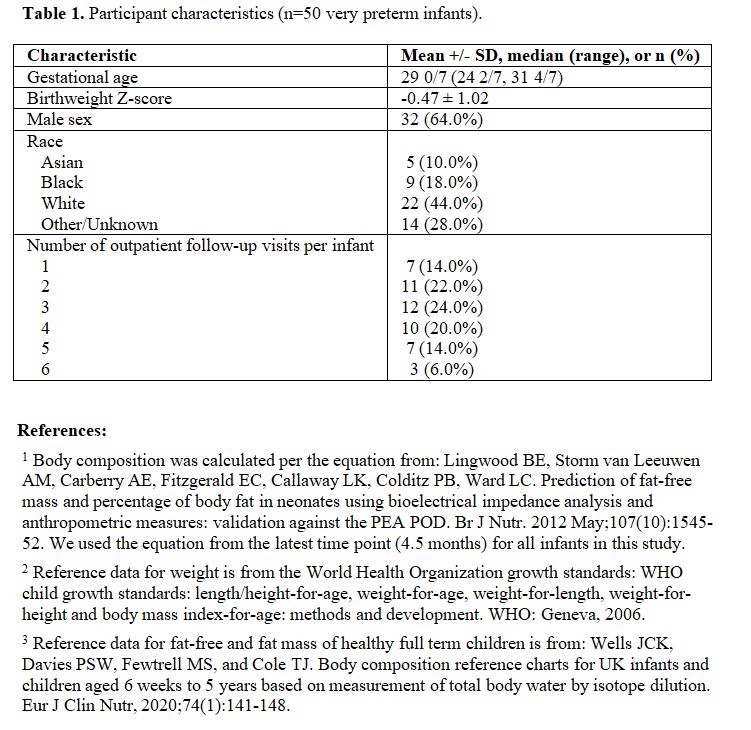Neonatal General 8: Growth, Nutrition and Feeding
Session: Neonatal General 8: Growth, Nutrition and Feeding
682 - Very preterm infants demonstrate persistent fat-free mass deficit and excess adiposity after NICU discharge
Saturday, April 26, 2025
2:30pm - 4:45pm HST
Publication Number: 682.7002
Katherine Bell, Brigham and Women’s Hospital, Boston, MA, United States; Deborah Cuddyer, Brigham and Women's Hospital, Braintree, MA, United States; Julianne B.. Woodward, Amherst College, Dover, MA, United States; Wei Wang, Brigham and Women's Hospital, Boston, MA, United States; Carmina Erdei, Brigham and Women's Hospital, Harvard Medical School, Boston, MA, United States; Mandy Belfort, Harvard Medical School, Boston, MA, United States

Katherine Bell, MD (she/her/hers)
Assistant Professor
Brigham and Women’s Hospital
Boston, Massachusetts, United States
Presenting Author(s)
Background: Infancy is a critical developmental period for programming of later-life health. For preterm infants, body composition is an important indicator of nutritional status that is linked to brain development and cardiometabolic outcomes. During the several months’ long neonatal intensive care unit (NICU) hospitalization, preterm infants experience reduced accretion of fat-free mass (FFM) but excess adiposity accumulation relative to the healthy fetus. Yet, little is known about how body composition changes in the early years after NICU discharge.
Objective: To determine trajectories of body composition (FFM and fat mass) among preterm infants after NICU discharge to 3 years old, and compare to reference values for healthy children born full term.
Design/Methods: This prospective observational study enrolled very preterm ( < 32 weeks gestational age) infants aged 0-3 years in a single center outpatient NICU Follow-Up Program. At 4, 8, 12, 18, 24, and 30-36 months corrected age, we measured weight and length, and performed bioelectrical impedance analysis to determine body composition (see reference 1 in footnote of Table 1). We calculated Z-scores for anthropometrics and body composition from published references (see references 2,3 in footnote of Table 1). We visualized longitudinal trajectories of growth using spaghetti plots for individual trajectories and locally weighted polynomial regression (LOESS) for group trajectories, and used a linear mixed model to calculate group mean FFM Z-score change over time.
Results: We studied 50 infants born at median gestational age 30 weeks (range, 24 2/7 to 31 4/7 weeks), 64% male (Table 1). Compared to reference data, preterm infants’ weight trajectories were similar to healthy full term infants of the same corrected age. However, body composition differed; fat-free mass Z-scores progressively declined (-0.077 units/month, 95% CI: -0.086, -0.067) and adiposity remained persistently high compared to reference data (Fig 1).
Conclusion(s): Very preterm infants experienced a progressive decline in fat-free mass relative to reference data, and persistently high fat mass over the course of early childhood, despite weight gain that tracked with the reference. These alterations in body composition may be relevant to early-life programming of neurodevelopment and cardiometabolic health in this vulnerable population.
Table 1

Figure 1
PAS abstract 2024 - Fig 1.pdf
Table 1

Figure 1
PAS abstract 2024 - Fig 1.pdf

